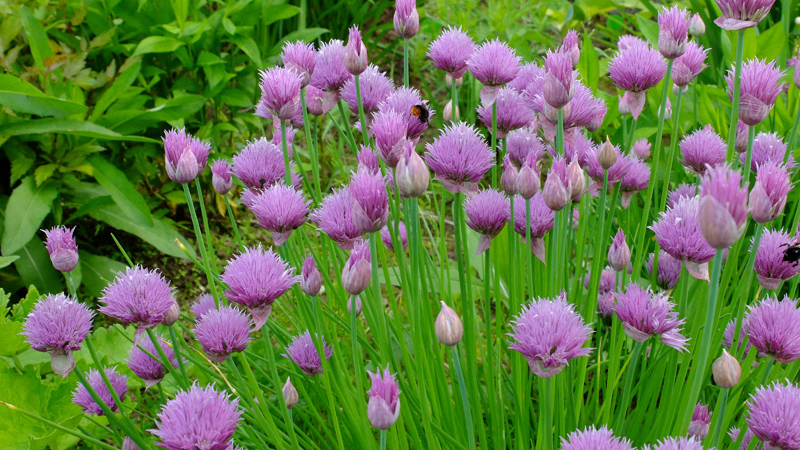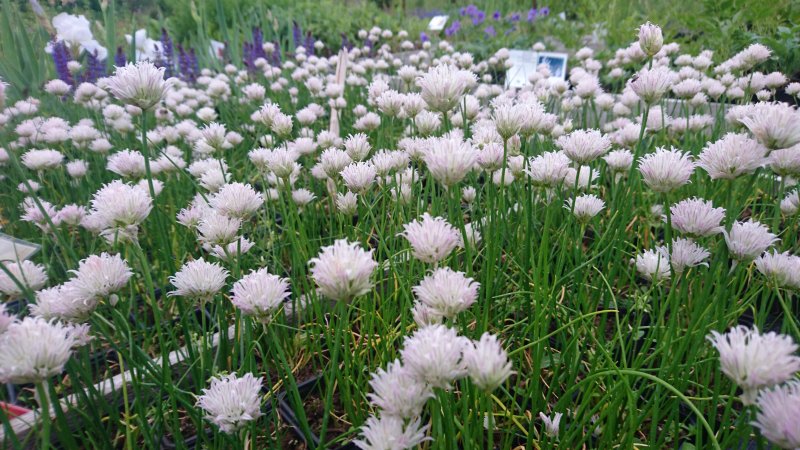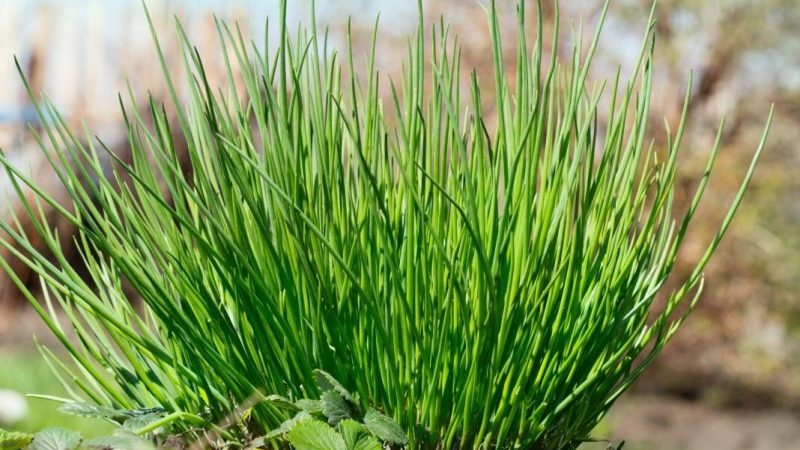Perennial table onion "Schnitt" and its varieties
Chives are one of the varieties of green onions that successfully combine a pleasant taste, rich vitamin composition and beautiful appearance. This onion is unpretentious, but still there are some nuances that must be taken into account if you decide to grow it on your site.
The content of the article
What it is
Chives (Rezanets, Chivis, Skoroda, Sibulet) is a herb that is grown as an annual or perennial crop. There are two varieties of Chivis - Siberian and Alpine, they differ in the size of the leaves and the degree of branching.

Origin and development
The homeland of chives is Asia, but the specific region is unknown, where for the first time its taste and benefits were appreciated.
The State Register of Russia includes 20 varieties of this onion.
Chemical composition and useful properties
Chives contains:
- zinc;
- manganese;
- iron;
- copper;
- selenium;
- phosphorus;
- potassium;
- magnesium;
- calcium;
- sodium;
- vitamins B1, B2, B4, B5, B6, B9, C, K, PP, A, E;
- beta carotene;
- amino acids;
- phytoncides;
- mineral salts;
- nitrogenous elements;
- fats;
- fiber;
- Sahara.
This vegetable enhances appetite, has a positive effect on the secretory activity of the intestines, the functioning of the kidneys, gallbladder and cardiovascular system. Onion chives is an effective means of preventing colds and infectious diseases, it is useful to use it for progressive atherosclerosis and as an anthelmintic.
Ripening period and yield

The ripening period and yield of Chivis depend on the variety. The table shows data for the most popular varieties.
| Variety | Ripening period | Productivity per cut |
| Albion | Mid-season | 1.7-2 kg / m² |
| Chemal | Early ripe | 1.6-2.1 kg / m² |
| Honey plant | Late maturing | 1.75 kg / ha |
| Spring | Mid-season | 1.5-2 kg / m² |
Disease resistance
With proper care, Sibulet is resistant to diseases and pests, but if agricultural technology is violated, onions can hit:
- onion thrips;
- rust;
- powdery mildew.
Characteristics of the bulb, description of the appearance, taste
The underground part of the Rezants is represented by 15-20 small oblong bulbs, colored brown-white or violet-red and attached to a short rhizome. The plant has a branched root system of thread-like shape, which is renewed every summer.
On the false stem, up to 10 cm high, there are 4-6 tubular or subulate leaves of a dark green color, 25-45 cm high and 5-8 mm in diameter.
Reference. For 3-4 years, chives form a bush 50-60 cm high, consisting of 40-100 stems with leaves and apical inflorescences.
Onions bloom from May to August, starting from the second year after planting. Inflorescences are semicircular in shape, consist of small umbellate flowers of various shades - from white to lilac and pale purple.
After flowering, a fruit-box is formed on the plant, inside which there are small seeds. The seeds reach full ripeness by the end of July-beginning of August, acquiring a black color.
Leaves and bulbs do not have bitterness, they taste like onions, but with a more delicate aroma.

For which regions it is best suited and what is the exacting climate
Chives prefer a temperate or continental climate. In Russia, it grows in the North Caucasus, Western and Eastern Siberia, Kamchatka, Primorsky and Khabarovsk territories, in the European part of the country.
Main advantages and disadvantages
Pros of Skoroda:
- frost resistance;
- abundant productivity;
- unpretentious care;
- pleasant taste;
- the possibility of using for decorative purposes.
Cons of culture - a tendency to disease with improper care and a short time storage greenery.
What is the difference from other varieties
Characteristics that distinguish chives from other members of the Onion family:
- high yield of greens;
- much earlier vegetation than onions;
- rapid growth of green mass;
- spectacular bloom;
- no traditional bulb.
Features of planting and growing

In comparison with onions, the seeds of Rezants are smaller and have poor germination, therefore it is especially important to prepare the planting material and soil before sowing, and choose the right planting time.
Preparing for landing
The inoculum is soaked in warm water for a day, then spread on a paper napkin or cloth and dried. This procedure helps to reject low-quality seeds that float to the surface, to increase their germination.
Reference. When winter landing seeds are not soaked, since they must be sown completely dry.
The plot is prepared in advance: in the case of spring sowing - in the fall, when planting before winter - in the summer. To do this, they dig up the earth, remove plant residues and weeds.
Lime is added to acidic soil, in all other types of soil - one bucket of humus or 0.5 liters of compost per 1 m². Also, the earth is fertilized with superphosphate and urea (1 tbsp. L. 1 m²).
In the spring, 2-3 days before sowing the seeds, ammonium nitrate or carbamide (15-20 g per 1 m²) is added to the soil.
Ground requirements
Chives grow well in nutritious, loose and well-drained soil. Do not plant it in sandy soil as it does not retain moisture well. The most suitable option is wet and lime-rich sandstone or loam.
Timing, scheme and landing rules
Seeds are sown in open ground in spring (late April or first half of May) or before winter (late September-early October). The division of the bush is carried out at the end of March, in April or in September.
Seed sowing algorithm:
- Prepare the beds and make 1-1.5 cm deep grooves on them every 20 cm.
- Water the furrows with warm water with the addition of complex fertilizers.
- Place planting material in them.
- Sprinkle the seeds with earth and compact it a little.
- Mulch the beds with sawdust or straw.
After 7-14 days, the first shoots will appear, they are thinned out so that the distance between the plants is 10 cm.
Reference. Chives are rarely grown from seed as they are difficult to harvest on your own. Most often, the division of the bushes is carried out.
Instructions for dividing the bush:
- Dig up the plant carefully.
- Slightly shorten the roots and divide them into several parts so that each one has at least 8-10 false bulbs with roots.
- In a prepared bed with a row spacing of 45 cm, dig holes 4-5 cm deep every 25 cm.
- Water the planting recesses with plenty of water.
- Place parts of the bush in them, deepening by 3.5-4 cm.
- Sprinkle the plants with soil and compact it slightly, water abundantly.
Growing features
The place for planting onions should be in partial shade - under the influence of direct sunlight, the greens quickly coarsen and lose their juiciness... It is better to plant a culture on a hill, because.in the lowlands there is a risk of moisture stagnation and excessive wetting of the roots.
The best predecessors and neighbors of Skoda - tomatoes, cucumbers, radishes, potatoes, carrots, herbs. You should not plant this onion after legumes, beets, cabbage.
You can grow chives in the same place no longer than 4-5 years - then the roots grow too much, which negatively affects the yield and quality of greenery.

The nuances of care
Sibulet is not picky about care. Knowing the nuances of watering, loosening and applying top dressing, even a novice gardener can get a good harvest.
Watering mode
Onions are watered abundantly approximately every 1-2 days, focusing on the state of the soil - it is important that the soil is always well moistened, otherwise the greens coarse and become tasteless. But waterlogging and waterlogging should not be allowed.
For irrigation, use clean, settled water without chlorine.
Reference. To retain moisture, the soil is covered with a layer of fine mulch.
Loosening the soil and weeding
The soil in the aisles is loosened at least 8-10 times per season to prevent the formation of a dense dry crust on the soil surface. Weeding is carried out regularly, since the weed, especially in the first year of onion cultivation, drowns out its growth and takes moisture and nutrients from the soil.
Top dressing
Fertilizers are applied starting from the second year of crop cultivation, after each leaf cut.
Top dressing options:
- ash - at the rate of 1 glass per 1 m²;
- rotted manure - 1 kg of manure per 15 liters of water;
- bird droppings solution - 1 kg per 20 liters of water;
- complex mineral fertilizers - "Nitrofoska", "Ammofoska", "Kemira".
If the onion grows in fertile soil and quickly builds up green mass, use only organic fertilizers or do not feed the onion at all.
Disease and pest control
With improper care, Sibulet can be affected by such diseases and pests:
- onion thrips - the affected bushes are dug up and heated in hot (+ 50 ° C) water, then dried in the sun and again planted in the ground;
- rust and powdery mildew - diseases cannot be treated, so the infected bushes are dug up and burned, and the beds are treated with Topaz, Fundazol, Fitosporin or Vitaros fungicides.
Harvesting and storage
Chicken is usually grown for its juicy, spicy greens. The special advantage of this onion is the ability to cut it several times per season.
How and when to collect
The first cut of greens is carried out in May, when the leaves grow to 20-25 cm in height, the second - when they grow back to 25 cm, the third - around the end of September, so that the onions have time to get stronger before the onset of cold weather.
Storage features and keeping quality of the variety
Greens Frying pans can be stored in a refrigerator or cool room for no more than two weeks. To increase the shelf life, it is frozen, salted, dried or pickled.
What can be the difficulties in growing
The main problems that can arise when cultivating chives:
- dark brown spots appear on the leaves - this is probably rust, which occurs when excessive watering or the use of cold water;
- a sticky white bloom forms on the leaves, they curl and wither - a sign of powdery mildew, which has developed due to thickening of plantings and improper watering.
Tips from experienced gardeners
Experienced farmers recommend doing the following for a good harvest:
- To scare away pests spray the plantings with a solution of tobacco and liquid soap.
- Use self-collected seeds within two years.
- In the first year after planting, do not cut the greens at all, or do a maximum of two cuts, otherwise the plant will weaken.
Reviews of chives
Many gardeners grow chives to get fresh greens in summer and leave only positive reviews about different varieties.
Vera, Khabarovsk: «We bought a house 10 years ago, and this onion grew there by itself along the road. The ground there is bad - solid sand, so the bushes were nondescript.But I liked how they bloom, I dug a few and planted them on the site. For several years it delighted me with flowering, and then I found out that it is also edible and very tasty. Now we have a small plantation of chives, we really love it, the main thing is to water it regularly ”.
Olga, Krasnodar Territory: "I have been growing chives for a long time, as it grows in the photo on the Internet, with beautiful flowers. It is, of course, delicious, but I plant it not even because of this. For me, its main value is the smell, which repels pests from onions. "
Conclusion
Schnitt is a rather unusual onion that many summer residents fell in love with not so much because of its taste, but because of its decorative appearance. This is an unpretentious culture, and if you follow the care recommendations, you can not only get a rich harvest of tasty and healthy greens without problems, but also decorate your site.